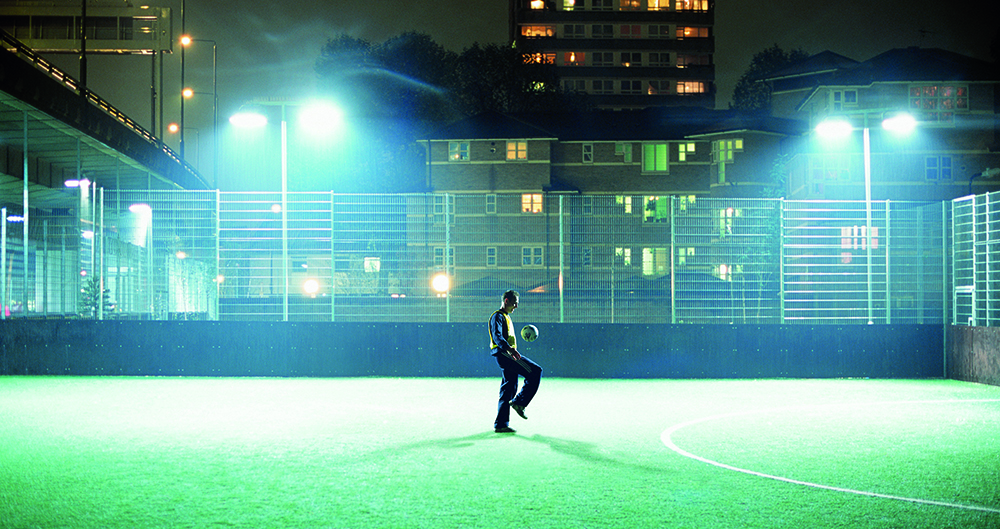How to Become a Better Football Player
Use pro training tactics from strength and conditioning coach Paul Winsper, who has worked with elite athletes including David Beckham

Increase Stability
Unless you are actually a hindrance to your team, your first job is to make sure you spend less time sidelined through injury. “Everyone always tries to get athletes to be faster and stronger but they’re always breaking down because there’s a fundamental disconnect in how their body is moving,” says Winsper.
“We get every athlete to work on mobility at the start of a session. Get down on one knee and then use your hands to push your front knee over your big toe to stretch the back of the ankle. Stay in that position, then tilt your pelvis forwards to stretch your hip. From that position, place your hands behind your head and tilt from one side to the other and then rotate from one side to the other to work the thoracic spine.” Repeat the drill with the other foot forward.
Build Speed
If you want to do something impressive with the ball, first you need to get hold of it. To do that, work on your short sprint speed – the ability to spot and make an interception is preferable to tackling, which risks both conceding a foul and injury. It’s rare that you’ll have to go full pelt for 60m so keep sprints short. “It’s important to do speed work at the start of a training session when a player is fresh,” says Winsper. “It could be something as simple as half a dozen short, sharp sprints. You don’t have to do a full speed session but you do need to do it at the start when your nervous system is fresh. You also need to know that all great speed is underpinned by strength and stability. You don’t want athletes sprinting flat-out if they don’t have the strength to back it up.”
RECOMMENDED: Football Training Drills Used by Memphis Depay
Master Deceleration
Your first touch is likely to improve if you can control how you arrive at the ball – and that means mastering deceleration. “We do a lot of work, from the academy systems right through to the highest level, teaching athletes to decelerate,” says Winsper. “The more force a player produces, the more they have to reduce to stop. You want to drive your heel into the ground to decelerate if you’re running really fast. We take them through a programme to ‘own the movement’ first, making sure the underpinning strength is there to decelerate properly – which means that the glutes fire, the hamstrings are working with the glutes and they’re using the correct part of the foot to decelerate. It’s also about being in control of your hip position. The hips dictate how you control your movement.”
RECOMMENDED: 5-a-Side Football Tips, Tactics and Workouts
Develop Agility
To intercept the ball or create space so you’re in a good position to receive it, you’ll need to work on your ability to change direction. All you need are a few cones and a couple of team-mates to race against. “A simple but effective sequence is to do a short sprint, a little back-pedal and then a sprint off at a different angle,” says Winsper. “Once you can control that, you can start to work on agility, which is change of direction in response to a stimulus. That’s when we add in a competition: you have two players in the centre and you’ve got different coloured markers at 12m, 10m, 8m, 6m and 4m. The coach might shout ‘blue’ and they race to the blue cone, and then maybe the coach shouts ‘red’ when the athletes are halfway, so they’ve got to execute the skill under pressure.”
Sign up for workout ideas, training advice, reviews of the latest gear and more.
RECOMMENDED: Pre-Season Football Fitness Drills
Improve Strength
“Once we’ve made sure the player’s joint is stable, we start to add the muscle architecture – the ability of the muscle tissue to produce force,” says Winsper. “We develop pushing and pulling movements, both horizontally and vertically, rotating, hingeing from the hips and squatting. I wouldn’t start with a soccer-specific programme – I’d start with an athlete-building programme. Once you’ve done that you can be more sport-specific, such as doing single-leg Romanian deadlifts or lateral hops into explosive sprints.” Do single-leg Romanian deadlifts by holding a pair of dumbbells at the top of your thighs while standing on one leg. Hinge at the hips to move the weights down the front of your standing leg until you feel a strong stretch in your hamstrings, then straighten up again.
RECOMMENDED: The Best 5-A-Side Football Boots
Boost Recovery
This is one area where you can mimic the pros’ habits – as long as that means having a leisurely Fifa session on the sofa rather than rolling out of a nightclub at 4am. “Go for the basics first,” says Winsper. “Make sure you’re refuelling, rehydrating and resting. Those are the non-negotiable elements.” Sadly, that means swerving a post-match pint. Your post-match meal, meanwhile, should contain a healthy portion of protein to assist muscle recovery and some complex carbohydrates to top up your glycogen (energy) stores.
“If you’re an amateur athlete, you might not have access to an ice bath but you can have a cold shower on the legs and try to get to a swimming pool the day after the game.”
RECOMMENDED: 8 Five-A-Side Football Crimes
Paul Winsper is an Under Armour ambassador
Coach is a health and fitness title. This byline is used for posting sponsored content, book extracts and the like. It is also used as a placeholder for articles published a long time ago when the original author is unclear. You can find out more about this publication and find the contact details of the editorial team on the About Us page.

